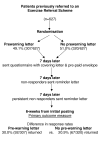Increasing response to a postal survey of sedentary patients - a randomised controlled trial [ISRCTN45665423]
- PMID: 15537429
- PMCID: PMC534787
- DOI: 10.1186/1472-6963-4-31
Increasing response to a postal survey of sedentary patients - a randomised controlled trial [ISRCTN45665423]
Abstract
Background: A systematic review identified a range of methods, which can influence response rates. However, analysis specific to a healthcare setting, and in particular, involving people expected to be poor responders, was missing, We examined the effect of pre-warning letters on response rates to a postal survey of sedentary patients whom we expected a low rate of response.
Methods: Participants were randomised to receive a pre-warning letter or no pre-warning letter, seven days before sending the main questionnaire. The main questionnaire included a covering letter and pre-paid return envelope. After seven days, non-responders were sent a reminder letter and seven days later, another reminder letter with a further copy of the questionnaire and return envelope.
Results: 627 adults, with a mean age of 48 years (SD 13, range 18 to 78) of whom 69.2% (434/627) were women, were randomised. 49.0% (307/627) of patients were allocated to receive a pre-warning letter and 51.0% (320/627) no pre-warning letter, seven days in advance of posting the main questionnaire. The final response rate to the main questionnaire was 30.0% (92/307) amongst those sent a pre-warning letter and 20.9% (67/320) not sent a pre-warning letter, with an adjusted odds ratio of 1.60 (95% CI 1.1, 2.30).
Conclusions: The relatively low cost method of sending a pre-warning letter had a modest impact on increasing response rates to a postal questionnaire sent to a group of patients for whom a low response rate was anticipated. Investigators should consider incorporating this simple intervention when conducting postal surveys, to reduce the potential for nonresponse bias and to increase the study power. Methods other than postal surveys may be needed however when a low response rate to postal surveys is likely.
Figures
References
-
- Abramson JH. Survey Methods in Community Medicine. 4. Edinburgh: Churchill Livingstone; 1990.
-
- Armstrong BK, White E, Saracci R. Principles of exposure measurement in epidemiology (Monographs in epidemiology and biostatistics, vol 21) New York : Oxford University Press; 1992. pp. 294–321.
-
- Bostrum G, Hallquist J, Haglund BJ, Romelsjö A, Svanström L, Diderichsen F. Socioeconomic differences in smoking in an urban Swedish population. The bias introduced by non-participation in a mailed questionnaire. Scand J Social Med. 1993;21:77–82. - PubMed
-
- Hill A, Roberts J, Ewings P, Gunnell D. Non-response bias in a lifestyle survey. J Public Health Med. 1997;19:203–207. - PubMed
-
- Jackson R, Chambless LE, Yang K, byrne T, Watson R, Folsom A, Shahar E, Kalsbeek W, for the Atherosclerosis Risk in Communities (ARIC) Study Investigators Differences between respondents and nonrespondents in a multicenter community-based study vary by gender and ethnicity. J Clin Epidemol. 1996;49:1441–1446. doi: 10.1016/0895-4356(95)00047-X. - DOI - PubMed
Publication types
MeSH terms
Associated data
LinkOut - more resources
Full Text Sources



